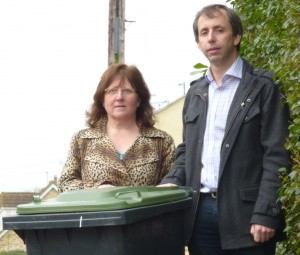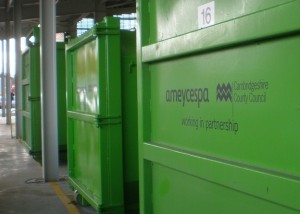The wheelie bins most of us received just over twelve months ago have already made a huge improvement to recycling in East Cambridgeshire. Our area is now the third highest mover in recycling rates over the past year, according to this article. We’ve still a way to go before we hit the really high spots, but it shows what a difference it makes to have the new bins.
Gaining seats from Tories and Labour
Seven and a half weeks ago victorious Liberal Democrats took Epping Hemnall (Epping Forest District Council) from the Conservatives. And on Thursday this week the Liberal Democrats gained Queen Edith’s (Cambridge City Council) from Labour. It’s real votes in real ballot boxes that count, and these results show there’s all to play for next May here in the East of England. Congratulations to respective winners Kim Adams and Viki Sanders!
Last call for black bin bags
If you haven’t had your annual supply of black bin bags yet, you have only a few days left to tell the council! Email customerservices@eastcambs.gov.uk or phone 01353 665555 before Friday (Halloween, 31 October).
Boundary review
The Local Government Boundary Commission has just confirmed that it will be reviewing the size of East Cambridgeshire District Council in 2015/16. The process includes drawing up proposals for public consultation, and may result in a different number of councillors and a different arrangement of wards. Sutton could lose one of its two councillors, for example, or share councillors with one or more neighbouring areas.
Ely crossing effects need funding too
At tonight’s meeting of East Cambridgeshire District Council, the council agreed to add the Ely crossing to the list of major schemes that might receive funding from the district’s ‘Community Infrastructure Levy’ – the newly-introduced pot of money the council receives as a result of development in its patch.
I made the point that the Ely crossing, while it might alleviate traffic at the station, would create new traffic problems elsewhere – in several other streets in Ely, for example, at the A10, and of course in Sutton itself, where it is likely that HCV traffic will increase as a result of the scheme. These problems will also need solutions, and I have therefore told the council that it should be aware of the need to add these to the ‘Community Infrastructure Levy’ list of significant schemes requiring funding in the future.
New polling station for Sutton
Residents of Sutton will in future vote at election time in the Royal British Legion hall at the Brooklands Centre, East Cambridgeshire District Council has confirmed.
The decision was made on Thursday 16 October at a meeting of the full council, which reviewed polling stations across the district.
Macmillan coffee morning
Another brilliant success for Nellie’s, who today hosted a Macmillan coffee morning at Scott Court. It was exceptionally well attended, with bric-a-brac and books for sale, a tombola and a raffle as well as a large array of cakes and bakes to accompany the teas and coffees. It’s great to see the community joining forces to make this event the success it was.
Monitoring our air quality
I recently had a useful meeting at the council to try to find out more about the way in which our air quality is monitored in East Cambridgeshire. The presence of particulates and other pollutants in our air is something that has caused some residents concern, particularly in view of the large numbers of heavy vehicles thundering through our village every day.
The council is obliged under the Environment Act 1995 to assess and report local air quality, including assessment of a range of pollutants including nitrogen dioxide (NO2) and particulates.
Measuring nitrogen dioxide
Measurement of nitrogen dioxide is mostly done using small tube monitors fixed to lamp posts at a range of locations in the district. The tubes most relevant to Sutton are at the junction with Tramar Drive and at the A142 at Witcham Toll. These monitors measure NO2 over a period of time.
Continuous monitors give a more accurate measure of NO2 in the atmosphere. There is only one continuous monitor in East Cambridgeshire, which is hired from another council, and costs £5,800 a year to run. This monitor gives readings as 15 minute mean averages. Originally partially funded by Sainsbury’s, this monitor is now funded by the County Council under its Local Transport Plan. King’s College London undertakes the data management for the monitor, which involves checking the data for anomalies and removing them.
Measuring particulates
There is only one piece of equipment in East Cambridgeshire to measure particulates, located at Wicken Fen; it measures PM10 (larger concentrations of particulates), and is hired from Fenland District Council. It is resource-intensive to run, and is situated alongside DEFRA equipment in their station there. It is not yet online, but replaces one that was previously located there. Its rural location provides some idea of the ‘baseline’ level of particulates in the district – that is, what the air would normally be expected to be like well away from traffic and other sources of pollution.
This PM10 monitor, known as a ‘Met One BAM’, uses low-level radiation to measure particulates. More equipment to measure PM10 would be comparatively cheap to purchase but would cost in the region of £1,600 a year to run, and would need to be housed somewhere.
Equipment for measuring PM2.5 (the smaller and more dangerous concentrations of particulates) is much more expensive to buy – potentially £20,000 or more – and in any case there is as yet no clear guidance on what items of equipment and methodologies are acceptable to DEFRA as reliable ways of measuring PM2.5.
If villages like Sutton are to build a conclusive argument for a lorry ban, we need a lot more testing – the 24 hour ‘safe limit’ for PM10 must be exceeded on at least 30 occasions in a year for a breach of the limit to be said to have occurred. That means a lot of testing – and without permanent PM10 monitors, and the budget to run them, gathering that body of evidence is difficult. That’s something the Joint HCV Group of local villages, which includes Sutton, is currently grappling with.
Three days to save our recycling centres
Witchford and Bluntisham recycling centres could close permanently, depending on the outcome of a county council consultation which closes this Friday (26 September).
Members of the public are invited to complete the consultation online. (Follow the link that says Household Recycling Service Review Survey just above the subheading ‘Description’). If you value your local recycling centre, it’s important to complete the consultation and show the county council why it’s needed.
The county council is seeking ways to save £149 million over the next five years, with part of that saving coming from the recycling centres. The options the county council is considering include any or all of
- complete closure of up to three recycling centres
- transfer of up to three recycling centres to an external operator
- closure of each centre for two weekdays each week
- reduction of opening hours at all centres
- charging for some items or
- issuing a limited number of permits for larger vehicles and trailers.
There are nine recycling centres in the county, at Alconbury, Bluntisham, March, Milton, St Neots, Thriplow, Whittlesey, Wisbech and Witchford. Of these, Witchford receives the fourth largest quantity of waste, at 7,941 tonnes in 2013/14 – beaten only by Milton, St Neots and Bluntisham. A decision will be made by the county council’s Highways and Community Infrastructure Committee in the autumn.
My view is that closing recycling centres, or otherwise making it more difficult for people to use them, will simply result in an increase in fly-tipping. Clearing up fly-tipping is the responsibility of the district council not the county council, so it could be argued that this is just one level of local government pushing its problems onto another. And we know that East Cambridgeshire District Council has a poor record of tackling fly-tipping, with very little funding going to support this part of its work, and an absence of any prosecutions even for the most blatant offences.
Sutton to Ely cycle way
Plans for developing a direct cycle route from Sutton to Ely are pressing on apace. Funding has been provided to the County Council to develop the area along the A142 from Wentworth junction to the area west of Witcham Toll. A shared use pedestrian and cycle path will be constructed that will be approximately 1.8m to 2m wide.
This path will provide a link between the existing paths from Sutton to the Witcham Toll area and Wentworth to Witchford. This will support a cycle and pedestrian path from Sutton to Ely. Links around the area of Witcham Toll are limited in space and while this area will have paved access, this means that some reallocation of space will be needed.
The cost of this scheme is £350,000, and the money has come from the Department for Transport. It is intended to begin Phase 1 in early autumn, and Phase 2 around Witcham Toll in late autumn.
If you have any questions, you can contact project manager Paul Rawlinson at the County Council by phone on 01223 699906 or by email at transport.delivery@cambridgeshire.gov.uk. Congratulations to Paul for getting this scheme under way.





